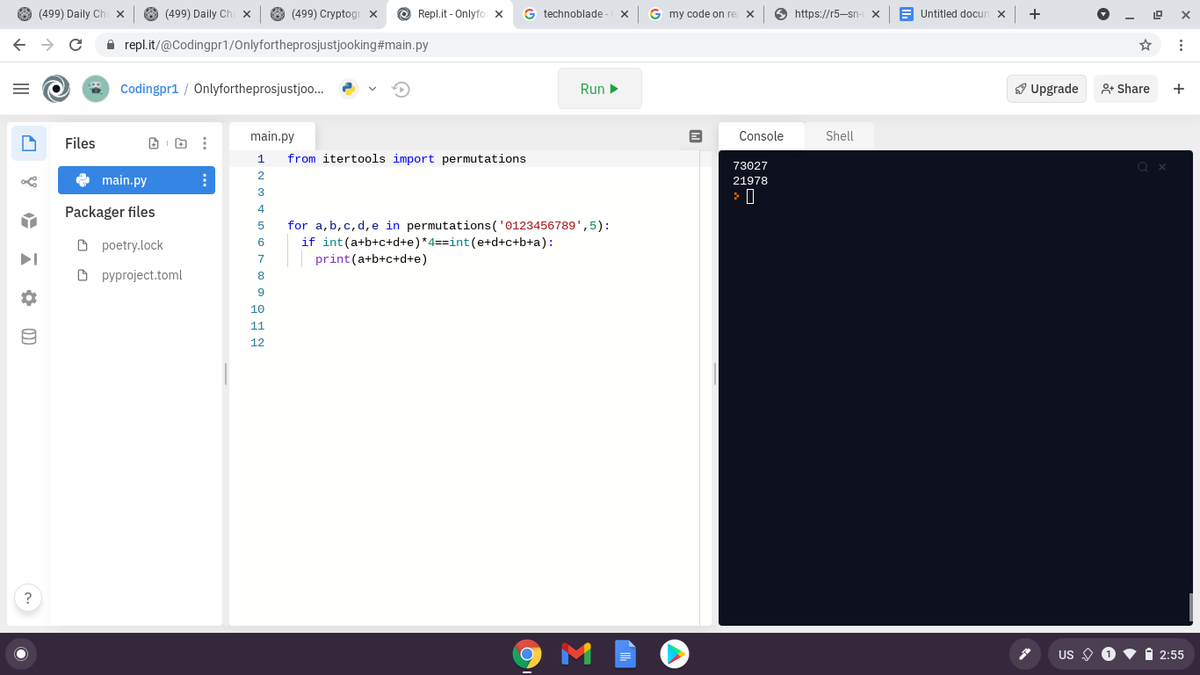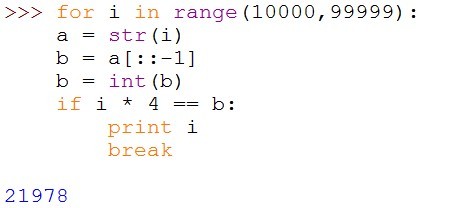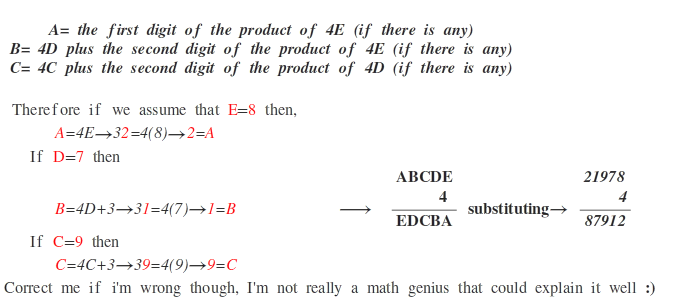The Egyptian Pharaoh
× A E B D C C D B E 4 A
Once there was a pharaoh who had a dream. He wanted someone to interpret it. All failed to do it. Could you interpret it correctly?
The pharaoh, in his dream, saw the above multiplication.
Could you figure it out and tell us what the five digit number A B C D E is?
The answer is 21978.
This section requires Javascript.
You are seeing this because something didn't load right. We suggest you, (a) try
refreshing the page, (b) enabling javascript if it is disabled on your browser and,
finally, (c)
loading the
non-javascript version of this page
. We're sorry about the hassle.
12 solutions
Moderator note:
Fantastic! Fun fact: 2 1 7 8 × 4 = 8 7 1 2 .
Can you generalize this? That is for positive integer n ≥ 5 , find an n -digit positive integer such that when it is multiplied by 4 , the resultant number is the reversal of digits of the original number.
Reply at the Master Note.
Given n ≥ 5 call m = n − 4 .
Then the number
2 1 m - t i m e s 9 9 ⋯ 9 9 7 8
should work.
When you are finding A 0 should also be a possible number that you could think of (as well as 1 and 2). So E would have to be 5 (or 0 because the question does not clearly state that each letter is a different number). However this means that B 4+first digit of what c 4 provides us with would have to be ≥50 and this is not possible. So A=2.
I haven't actually tried weather there or other results if you don't follow the ruel that no number can be used twice.
Log in to reply
In cryptograms, it is implied that any leading digit must be non-zero. Generally they mention if no number can be used twice, but if not it's safer to assume they can't. However, for this particular problem, the only solution has distinct digits.
Under the given set of rules the easiest answer is actually 00000 but it is not accepted as an answer.
Log in to reply
That is why 0 is frequently known as a trivial solution. It is strictly not a five-digit number.
Given: ABCDE x 4 = EDCBA
The answer is: 21978 x 4 = 87912
But rather than just give you the answer, here's how I figured it out. First, it is obvious that A must be an even number, because we are multiplying by 4 (an even number). The last digit will therefore be even. It can't be 0, because that would make ABCDE a four-digit number. It can't be more than 2, because that would result in a six-digit answer. So A = 2.
2BCDE x 4 = EDCB2
So what can E be? The choices are E = {3, 8} because 3 x 4 = 12 and 8 x 4 = 32. But a value of 3 doesn't work in the result (3????) because it is too small.
2BCD8 x 4 = 8DCB2
Since the final number is 8 and we have 2 x 4, that means there is no carry from the prior multiplication (4 x B + carry). So B can't be anything higher than 1, possibly 0.
Looking at the other side of the equation, we have 4D + 3 = (a number ending in 0 or 1). In other words, 4D must end in 7 or 8. Obviously only 8 works, because 4 is an even number. Working forward again, that means B = 1.
21CD8 x 4 = 8DC12
So what values of 4D result in a number ending 8? 4 x 2 = 8, 4 x 7 = 28. Now 2 is already taken and the problem said the digits were unique. So D = 7.
21C78 x 4 = 87C12
Finally, we have a carry of 3 (from 28 + 3 = 31). And when we calculate 4C + 3 it must also result in a carry of 3 and a last digit of C. In other words: 4C + 3 = 30 + C
This is easy to solve: 3C = 27 C = 9
Thus the final answer is: 21978 x 4 = 87912
Moderator note:
This solution is incomplete.
"So B can't be anything higher than 1, possibly 0." Why can't B equals to 2?
You could phrase your working for B better: With 4 D + 3 ≡ B m o d 1 0 . With possible values of B as 0 , 1 , 2 only shows that B = 1 .
"and the problem said the digits were unique", there's no indication that all digits A , B , C , D , E are distinct.
This solution is belong to Soumek Mishra
Will some one pl tell me which app to use to type the answers like this
Well let me throw some light in this solution.B can be 1 or 2. Now 4.8=32 with carry of 3. Now 4.(D)+3=an odd number.So B cannot be 2 as any number ending with 2 or 2 itself is an even number.Hence B is 1.
That's how cryptarithms are, is with distinct digits. That's just a given. But if it's not a given here, then the answer is that D must be odd, since we are carrying a 3 into the tens' column.
A must be less than 10 so that the number stays 5 digit. There can be two values for A, 1 and 2. But since the number is multiplied by 4 it is even. So A is 2.
E can be 8 or 9. E x 4 should have 2 in ones digit. 9 x 4 is 36, 8 x 4 is 32. E now is 8.
Next, B can be 0,1,2. D x 4 + 3 gives an odd number. So B is equal to 1.
D can be 2 or 7. Since 2 x 4 + 3 is 11 and 7 x 4 + 3 is 31 which both result to 1 in the ones digit. But B x 4 ranges from 4 to 9 so we cant have 2 for D. Therefore D is 7.
C x 4 + 3 should be 30 to 39 so that B x 4 + 3 = 7 = D. C now is from 7 to 9. 7 x 4 + 3 is 31, 8 x 4 + 3 is 35, 9 x 4 + 3 is 39. C x 4 + 3 should have C in its ones digit. So C now is 9.
The number is 21978..
Moderator note:
Great. Simple and straight to the point.
Okay, so we have A B C D E ∗ 4 = E D C B A .
Since E D C B A is a multiple of 4 , it is an even number, and thus A must be even. Furthermore, since E D C B A has 5 digits, A B C D E can be at most 2 4 9 9 9 , for 2 5 0 0 0 ∗ 4 = 1 0 0 0 0 0 .
Thus, A is either 0 or 2 .
Suppose that A = 0 ; this gives us E = 0 or E = 5 , since the only digits that multiplied by 4 ends in 0 are 0 and 5 . Suppose that E = 0 ; then, B C D 0 ∗ 4 = D C B 0 . Then, since the greatest value for D C B 0 is 9990, we have that B C D 0 ≤ 2 4 9 5 ; thus, B ≤ 2 . If B = 0 , then: C D 0 ∗ 4 = D C 0 0 . Since C D 0 is at most 9 9 0 , then D C 0 0 ≤ 3 9 6 0 , and so D ≤ 3 . However, since D 0 ∗ 4 must end in 0 0 , then D = 0 , which gives us C 0 0 ∗ 4 = C 0 0 , which implies that C must be 0 as well - and we have a solution, " 0 0 0 0 0 " which I don't think that counts... Let's keep going.
If B = 1 , we'd have: 1 C D 0 ∗ 4 = D C 1 0 , which doesn't work because the last two digits of all multiples of four must form a number divisible by 4 - and 1 0 isn't.
If B = 2 , then: 2 C D 0 ∗ 4 = D C 2 0 . Now, we must have D = 3 or D = 8 , since these are the only digits that when multiplied by 4 yield a last digit of 2 . However, since B = 2 , then D = 8 , for all numbers between 2 0 0 0 and 2 4 9 9 , when multiplied by 4 , begin either with 8 or 9 .
Then, we have: 2 C 8 0 ∗ 4 = 8 C 2 0 . From previous calculations, we've established that C ≤ 4 . Let's test this:
2 0 8 0 ∗ 4 = 8 3 2 0 = 8 0 2 0
2 1 8 0 ∗ 4 = 8 7 2 0 = 8 1 2 0
2 2 8 0 ∗ 4 = 9 1 2 0 = 8 2 2 0
2 3 8 0 ∗ 4 = 9 5 2 0 = 8 3 2 0
2 4 8 0 ∗ 4 = 9 9 2 0 = 8 4 2 0
Thus, this condition does not yield a solution. Let's turn to the other case, where E = 5 .
We can write: B C D 5 ∗ 4 = 5 D C B 0 . However, the smallest 5 -digit number, 5 0 0 0 0 , when divided by four, is 1 2 5 0 0 , which is still a 5 -digit number. Thus, we must have A = 2 .
If A = 2 , then we must have either E = 3 or E = 8 in order for the last digit of E B C D A being equal to 2 , since these are the only digits that when multiplied by 4 give us a last digit of 2 . However, since we have A = 2 , then E must be equal to 8 , for any number between 2 0 0 0 0 and 2 4 9 9 9 when multiplied by 4 begins with either 8 or 9 ; we now have: 2 B C D 8 ∗ 4 = 8 D C B 2 .
The greatest number of the form 8 D C B 2 is 8 9 9 9 2 , that when divided by four yields 2 2 4 9 8 . This limits the value for B : B ≤ 2 . Now, if B = 0 , then 8 D C 0 2 can never be divisible by 4 since all multiples of 4 have the number formed by their last two digits also divisible by 4 . This also occurs if B = 2 , but not if B = 1 , though - 2 2 is not divisible by 4 , but 1 2 is indeed a multiple of 4 , so it's valid to assume that B = 1 .
Now, we have: 2 1 C D 8 ∗ 4 = 8 D C 1 2 . The greatest number that theoretically could be formed is 2 1 9 9 8 ; when multiplied by 4 , it yields 8 7 9 9 2 .
Now, from the previous calculation, we've established that D is at most 7 , Thus, we can write 0 ≤ D ≤ 7 . D cannot be 0 , since if it were, then the last digits of E B C D A would equal 3 2 and not 1 2 .
If D = 1 , then the last digits of E B C D A would be 7 2 ; if D = 2 , then the last digits of E B C D A would be equal to 1 2 and match. We'd then have: A B C D E = 2 1 C 2 8 ; however, 2 1 0 0 0 ∗ 4 = 8 4 0 0 0 , and so there is no matching C that can overcome the fact that this number, when multiplied by 4 , would be greater than a number of the type 8 2 C 1 2 .
Moving on, if D = 3 , then the last digits of E B C D A would be 5 2 ; if D = 4 , then these would be 9 2 ; if D = 5 , they'd be equal to 3 2 ; if D = 6 , they'd be equal to 7 2 .
If D = 7 , however, then the last digits are 1 2 . Then, we have: A B C D E = 2 1 C 7 8
When multiplying this number by 4 , we must again note that 2 1 0 0 0 ∗ 4 = 8 4 0 0 0 , which implies that C must provide a carry value of 3 on the thousand's place in order for the multiplication to hold. Thus, C = 8 or C = 9 ; if C = 8 is taken, it yields 2 1 8 7 8 ∗ 4 = 8 7 5 1 2 = 8 7 8 1 2 . We're left with C = 9 , and it does hold that 2 1 9 7 8 ∗ 4 = 8 7 9 1 2 . Therefore, A B C D E = 2 1 9 7 8 , and it's the only solution possible.
I discovered a secret, a most marvelous shortcut in which I can determine BA + 9 = AB. But I shall not share it
40000 A + 4000 B + 400 C + 40 D + 4 E = 10000 E + 1000 D + 100 C + 10 B + A
=> 39999 A + 3990 B + 300 C = 9996 E + 960 D {Better because simplified.}
We know A has to be smallest i.e. 1 or 2. However, with thorough scientific method:
FOR A:=1 TO 9 DO
FOR B:=1 TO 9 DO
FOR C:=1 TO 9 DO
FOR D:=1 TO 9 DO
FOR E:=1 TO 9 DO
Only A B C D E = 21978 is found. Checked 87912 to be correct.
Answer: 21978
Moderator note:
This solution is incomplete. You did not explain your motivation for assuming E = 8 nor did you prove that your solution is unique.
Exactly!
How do we know which value will satisfy the equation? There can be so many combinations? Isn't it?
I used simple code to solve this; sorry for being so awkward because this is so in the future:
 Don't mind the 73027 on the top line; that was from a previous output.
Don't mind the 73027 on the top line; that was from a previous output.
It's easy the only main thing is to see A should be less than 3 so, it can be 2 or 1 so, Put u r imagination on...!
1 2 3 4 5 6 7 8 9 10 |
|
Python
A bit of programming :P

wrong approach

× A E B D C C D B E 4 A
Therefore, A B C D E = 2 1 9 7 8